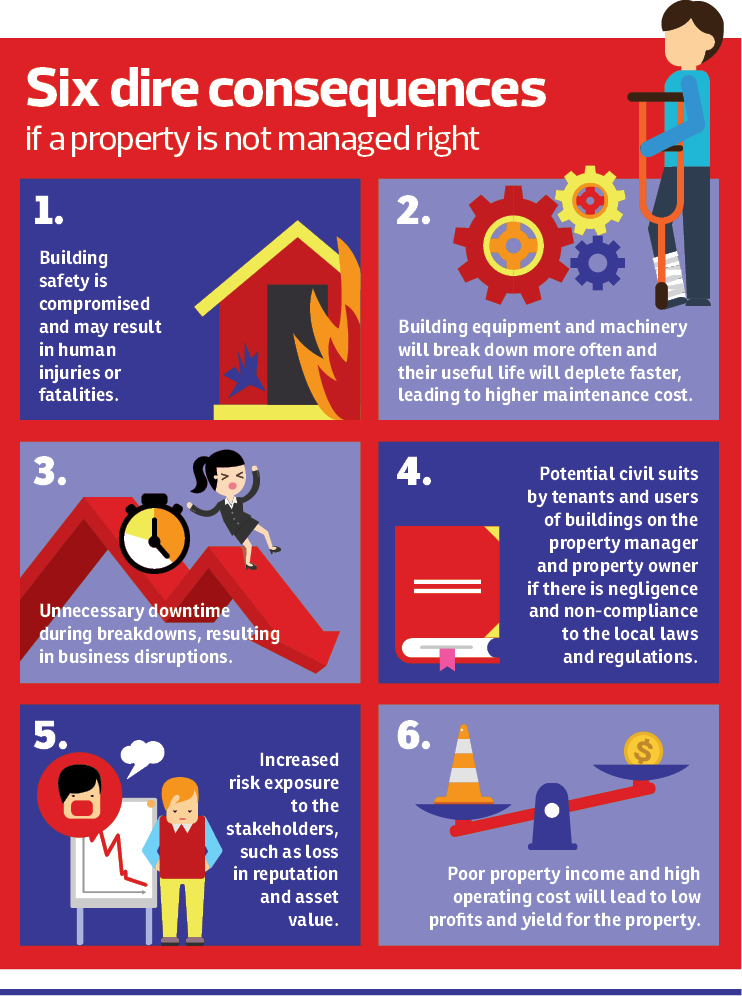Managing and maintaining commercial buildings such as malls and office buildings have its own set of challenges. What are some of these challenges and how do owners ensure that their buildings are able to maintain strong rental yields?
Have you come across the news of people being “swallowed alive” by malfunctioning escalators or of children falling to their deaths over loose railings in malls? While much emphasis is placed on property management of residential properties, such disasters show that it is just as pertinent, and maybe even more so, for commercial properties to adopt a good maintenance culture and adhere strictly to a regular maintenance schedule.

A property manager may find the requirements of owners and occupants of commercial properties, such as offices and malls, to be different from that of residential properties, says Malaysian REIT Managers Association chairman Datuk Jeffrey Ng.
Commercial building users are most likely professionals and entrepreneurs, thus they demand more than the basics of cleanliness, security, safety and provision of main utilities such as water and electricity.
“Owners and occupants of commercial properties often have specific space performance criteria that link clearly to their business productivity.
“Some of these occupants are multinational corporations and they have global standards on building performance and sustainability practices that may be difficult or too costly to comply with in the local context, especially when the building is already built,” Ng says.

Some of the challenges he describes cover a range of factors in building design and operations. These include:
1. Good floor efficiency and layout design that comply with stringent safety standards and good space utilisation
2. Efficient vertical transportation systems that minimise waiting time
3. Reliability in the provision of electricity and telecommunication services (in the case of MSC Status Buildings, a guaranteed 99.9% uptime in the provision of electricity and telecommunication services is required)
4. Air-conditioning supply with specified air temperature, humidity and operating hours
5. Provision of adequate daylight and lighting lumens within the enclosed space
6. Provision of adequate car parking facilities for both workers and visitors
“These pose a unique set of challenges to the property manager, who must possess a good understanding of business trends and requirements as well as design and maintenance of building facilities and M&E systems,” Ng notes.
How to increase rental yields
As rental yield is a function of rental income and a building’s operational cost, both these components need to be looked at carefully to ensure financial sustainability of the asset.
“In improving rental income of a building, it is important for the property manager to constantly review the changes in market trends and upgrade the building to maintain its competitiveness.
“Understanding customer needs and achieving a high level of customer satisfaction is the key. Understanding market trends will also lead to effective tenancy management strategies in space planning, pricing and avoiding tenancy renewals at the troughs of the property market cycles,” Ng shares.
On top of that, the ability to differentiate the property from the competition and to create a long-term competitive advantage in the market are important strategies in maintaining good rental income and property yield in the long run, he offers.
Ng says this can be achieved, for instance, by creating a captive market with a carefully planned integrated township comprising a mix of well-connected complementary developments such as office, residential, retail, hospitality, leisure, healthcare and education.
“This will provide good connectivity within the community, hence promoting exceptional convenience and business productivity. In addition, the various business components within an integrated development provide tremendous synergy to all users in the community,” he adds.
Monitoring expenses
On capital expenditure control, manpower and energy are two of the most critical components in building operation cost.
“Manpower cost must be managed through constant review of operational efficiency and adoption of technology that will reduce manual human operations,” Ng says.
For instance, better energy efficiency can be achieved through proper management and maintenance of the air-conditioning facilities and use of energy-efficient electrical fittings such as LED lights, motion sensors and others to minimise wastage.
“Liquefied petroleum gas is often used in shopping malls and hotels by F&B outlets and boilers. However, the use of natural gas and more efficient installations can reduce the overall gas consumption cost,” he suggests.
Energy management in a building, he adds, should also include the adoption of the Internet of Things and energy management software in managing the various variables within a building.
“Use of renewable energy is another consideration to reduce energy cost and our carbon footprint,” he says.
Preventive maintenance
According to Ng, facilities management is a key factor in raising property management standards in Malaysia. Facilities management focuses on the needs and well-being of the building occupants. It emphasises good planning and maintenance of all building facilities to achieve a high level of human productivity whilst maintaining a high level of safety and health standards.
“Facilities management also involves risk management in the day-to-day building operations and development of business recovery plans. Good facilities management further looks at financial and operational sustainability and promotes the holistic approach in achieving sustainable development goals,” he says.
He feels that one of the most overlooked aspects of commercial properties is its preventive maintenance, which is the key to prolonging the useful life of the asset.
“Strong commitment to continuously spend on maintenance regardless of the building occupancy level is often lacking.
“Good property maintenance should also include the adoption of the latest technology in maintenance to achieve optimum efficiency and human productivity. All these involve operation and capital expenditures,” Ng notes.

This story will appear in EdgeProp.my pullout on June 29, 2018. Download EdgeProp.my pullout here for free.






